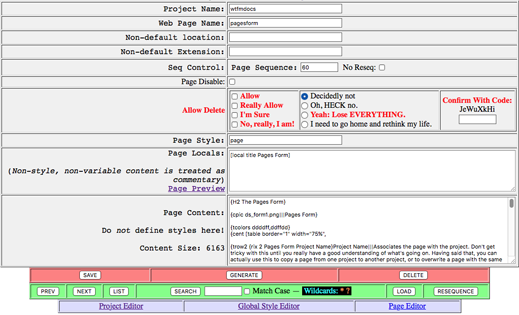4.2.3 - The Pages Form
 Pages Form
| Project Name |
Associates the page with the project. Don't get tricky with this until you really have a good understanding of what's going on. Having said that, you can actually use this to copy a page from one project to another project, or to overwrite a page with the same web page name in another project. You can't save a page without a valid, existing project name. |
| Web Page Name |
This is the name of the web page that is to be generated.
Don't add a filename extension such as '.txt' or '.html' onto this name.
Either let the extension be inherited from the Default Extension in the Project, or control the exception for this specific page using the Non-default Extension field as detailed below.
You can create new pages in the current project by changing this (you'll typically want to also change the Page Sequence value), then saving. Be careful. You can also over-write pre-existing pages in the current project that way. Take a look at the list of current pages to make sure you're not saving a page over another page you don't want to lose. You can't save a page without a valid web page name. |
| Non-default Location |
If this file is to be generated elsewhere than the default filesystem location set in the Project form, for instance into the CGI directory, or the CSS style directory, then put that filesystem location here. You can terminate the final directory with a slash, or not.
The permissions on this location must be set so that the documentation system can write there.
|
| Non-default Extension |
This can be blank, in which case the default page extension will be used, set to a single dash (-), in which case no extension will be used, or set to an extension such as .txt or .html and so forth. See also the explanation of Web Page Name, above. |
| Seq Control |
The Page Sequence number sets the Next-Previous sequence. RESEQUENCE, in the command bar, will renumber all pages in the project with an interval of 10, using the existing order of the sequence numbers as an ordering guide for the new page sequence numbers.
If you don't set this value, the page will be saved with a fixed sequence number of 10. Which will cause random ordering if more than one page with the sequence number of 10 is in the project when you next use RESEQUENCE — So don't forget to set this.  |
| Page Disable |
When checked, this will take the page out of the generated and Next-Previous sequence. No output is created when GENERATE is pressed.
Be aware that previously generated files may remain in the target directory.
|
| Allow Delete |
Accidental deletion has caused more harm than just about anything else I can think of. Consequently, here, you have to jump through all these hoops — five of them — or the Delete will just ignore you. You have to check all four checkmarks, select the obvious bullet, and copy and paste the code into the box provided. Then you can press Delete and it will actually work.
You can thank me later. |
| Page Style |
This style "wraps" the page. Typically, this will be a complete HTML skeleton. That's what is being used here, and in the demo project as well. |
Page Locals
and
Page Preview |
You typically define [local] and [style] here. You can still use the global forms, that is, [global] and [gstyle] , however, be aware that pages generated previously in the page sequence will not see these. Note the "Page Preview" link on the left in the Page Editor form. This lets you take a fast look at the page you're working on after a GENERATE.
If, in the Page Locals section, you place [local ds_rawmode 1] then the Page Content will be saved without any processing and will not be wrapped in the page style. This might be what you want for CSS files, for instance.
|
| Page Content |
This is where you create the page itself. Content here inherits the Global Styles, the Project Styles, and the Local Styles, in that order. It is then "wrapped" in the Page Style, and generated to the Target Directory.
Do not define styles in the Page Content container.
|
| Command Bars |
LOAD reloads the page, acting like a one-step "undo."
RESEQUENCE, following the page order defined by the current sequence numbering, updates all the page sequence values in the project to intervals of ten, thus providing fresh room for insertion between every page.
SEARCH is not case-sensitive unless you set Match Case x; the "?" character is a single-character wildcard, and the "*" character is a multiple character wildcard. Everything you enter is wrapped automatically with two '*', so you don't have to enter any wildcards to search for a word or phrase. So to search for the word "dinner", you would enter "dinner" into the search box and press SEARCH. To search only for 'Python' and not 'python', you would enter 'Python' and set Match Case x and press SEARCH. To search for bing or bong, you would enter 'b?ng' and press SEARCH — You might also get results for 'bang'.
All of the other commands save the page content first, then do whatever they say they're going to do. Obvious, I think. I'm sure I'll hear about it if it isn't.  |
| Link Bar |
The bar gives you access to the other forms. |
Keyboard Navigation
, Previous Page
. Next Page
t TOC
i Index

This manual was generated with wtfm
|
|